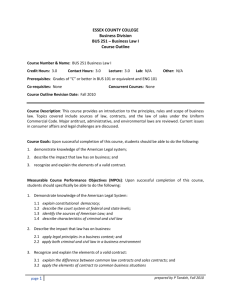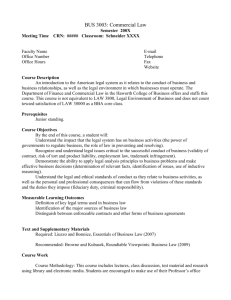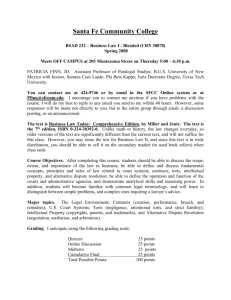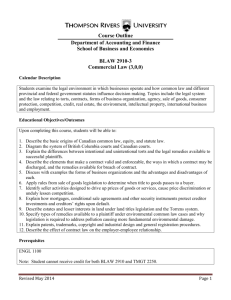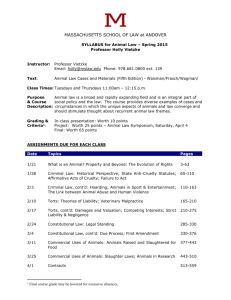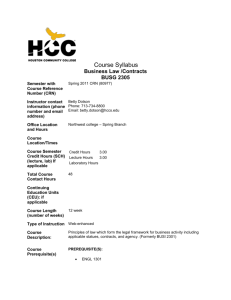bus.251.outline.f2010 - Student Learning Outcomes (SLO)
advertisement
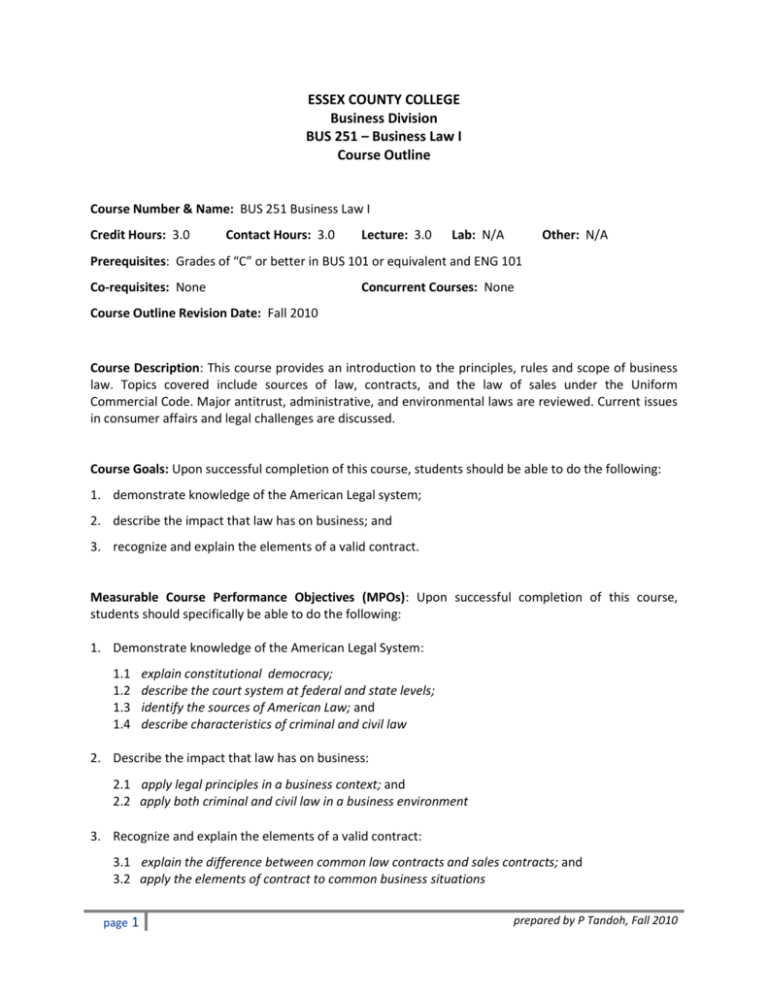
ESSEX COUNTY COLLEGE Business Division BUS 251 – Business Law I Course Outline Course Number & Name: BUS 251 Business Law I Credit Hours: 3.0 Contact Hours: 3.0 Lecture: 3.0 Lab: N/A Other: N/A Prerequisites: Grades of “C” or better in BUS 101 or equivalent and ENG 101 Co-requisites: None Concurrent Courses: None Course Outline Revision Date: Fall 2010 Course Description: This course provides an introduction to the principles, rules and scope of business law. Topics covered include sources of law, contracts, and the law of sales under the Uniform Commercial Code. Major antitrust, administrative, and environmental laws are reviewed. Current issues in consumer affairs and legal challenges are discussed. Course Goals: Upon successful completion of this course, students should be able to do the following: 1. demonstrate knowledge of the American Legal system; 2. describe the impact that law has on business; and 3. recognize and explain the elements of a valid contract. Measurable Course Performance Objectives (MPOs): Upon successful completion of this course, students should specifically be able to do the following: 1. Demonstrate knowledge of the American Legal System: 1.1 1.2 1.3 1.4 explain constitutional democracy; describe the court system at federal and state levels; identify the sources of American Law; and describe characteristics of criminal and civil law 2. Describe the impact that law has on business: 2.1 apply legal principles in a business context; and 2.2 apply both criminal and civil law in a business environment 3. Recognize and explain the elements of a valid contract: 3.1 explain the difference between common law contracts and sales contracts; and 3.2 apply the elements of contract to common business situations page 1 prepared by P Tandoh, Fall 2010 Methods of Instruction: Instruction will consist of a combination of any of the following: lectures, class discussion, group activities, and legal case reviews. Outcomes Assessment: Quiz, test, and exam questions are blueprinted to course objectives. Data collected will be analyzed to provide direction for the improvement of program instruction, viability of class assignments, relevancy of assigned course materials, and evaluation of instructional time spent on specific topics. Course Requirements: All students are required to: 1. Maintain regular attendance and participate actively in class discussions and activities. 2. Complete all assigned homework and readings from the textbook or other assigned course materials on time. 3. Take all quizzes, tests, and exams as scheduled. 4. Follow any specific class requirements mandated by the instructor. Methods of Evaluation: Final course grades will be computed as follows: Grading Components % of final course grade Homework, Quizzes, and Class Participation Homework consisting of case briefings and analysis and quizzes will provide evidence of the extent of student mastery of some course objectives. Outstanding class participation may be used, at the instructor’s discretion, to marginally increase the student’s final course grade. 20% 3 or more Tests (dates specified by the instructor) Tests will show evidence of the extent to which students meet course objectives. 30% Midterm Exam (date specified by the instructor) The midterm exam will provide evidence of the level of student synthesis of course material and mastery of course objectives covered in the first half of the semester. 25% Final Exam (date specified by the instructor) The final exam will examine the extent to which students can analyze, synthesize, and apply facts that are relevant to course objectives to given legal situations. This exam will provide evidence of the level of student mastery of course objectives covered throughout the semester. An increased level of content synthesis is also expected. 25% NOTE: Passage of the final exam is one of the requirements for passing the course. page 2 prepared by P Tandoh, Fall 2010 Academic Integrity: Dishonesty disrupts the search for truth that is inherent in the learning process and so devalues the purpose and the mission of the College. Academic dishonesty includes, but is not limited to, the following: plagiarism – the failure to acknowledge another writer’s words or ideas or to give proper credit to sources of information; cheating – knowingly obtaining or giving unauthorized information on any test/exam or any other academic assignment; interference – any interruption of the academic process that prevents others from the proper engagement in learning or teaching; and fraud – any act or instance of willful deceit or trickery. Violations of academic integrity will be dealt with by imposing appropriate sanctions. Sanctions for acts of academic dishonesty could include the resubmission of an assignment, failure of the test/exam, failure in the course, probation, suspension from the College, and even expulsion from the College. Student Code of Conduct: All students are expected to conduct themselves as responsible and considerate adults who respect the rights of others. Disruptive behavior will not be tolerated. All students are also expected to attend and be on time for all class meetings. No cell phones or similar electronic devices are permitted in class. Please refer to the Essex County College student handbook, Lifeline, for more specific information about the College’s Code of Conduct and attendance requirements. page 3 prepared by P Tandoh, Fall 2010 Course Content Outline: based on the text Business Law Today, 9th edition, by Miller & Jentz; published by South-Western, 2006; ISBN 13 #: 978-0-324-78615-6 Class Meeting (80 minutes) Chapter/Section CHAPTER 1 HISTORICAL AND CONSTITUTIONAL FOUNDATIONS 1.2 The Common Law Tradition 1.3 Classifications of Law 1.4 The Constitutional Powers of Government 1.6 Business and the Bill of Rights 1.7 Reading and Analyzing Case Law 1 2 CHAPTER 2 ETHICS AND BUSINESS DECISION MAKING 2.1 Business Ethics 2.2 Ethical Transgressions by Financial Institutions 3 5 CHAPTER 3 COURTS AND ALTERNATIVE DISPUTE RESOLUTION 3.1 The Judiciary’s Role in American Government 3.2 Basic Judicial Requirements 3.3 Alternative Dispute Resolution 6 Test #1 on Chapters 1, 2, and 3 7 8 9 10 11 CHAPTER 4 TORTS AND CYBER TORTS 4.1 Intentional Torts against Persons 4.2 Intentional Torts against Property 4.3 Unintentional Torts (Negligence) 4.4 Defenses to Negligence 4 12 13 14 CHAPTER 5 INTELLECTUAL PROPERTY AND INTERNET LAW 5.1 Trademarks and Related Property 5.2 Cyber marks Test #2 on Chapter 4 15 5.3 5.4 5.5 16 Midterm Exam 17 CHAPTER 6 CRIMINAL LAW 6.1 Types of Crimes 6.2 Defenses to Criminal Liability page 4 Patents Copyrights Trade Secrets prepared by P Tandoh, Fall 2010 Class Meeting (80 minutes) 18 19 20 21 22 23 Chapter/Section CHAPTER 8 CONTRACTS: NATURE, CLASSIFICATION, AGREEMENT, AND CONSIDERATION 8.1 Overview of Contract Law 8.2 Types of Contracts 8.3 Agreement 8.4 Consideration CHAPTER 9 CONTRACTS: CAPACITY, LEGALITY, ASSENT, AND FORM 9.1 Contractual Capacity 9.2 Legality 9.3 Voluntary Consent 9.4 Form CHAPTER 10 CONTRACTS: THIRD-PARTY RIGHTS, DISCHARGE, BREACH, AND REMEDIES 10.1 Assignment and Delegation 10.2 Third-party Beneficiaries 10.3 Contract Discharge 10.4 Remedies 24 Test #3 on Chapters 8, 9, and 10 25 CHAPTER 11 SALES AND LEASES, FORMATION, TITLE, AND RISK 11.1 The Scope of the UCC and Article 2 (Sales) and 2A (Leases) 11.2 Title and Risk of Loss 26 27 28 29 30 page 5 CHAPTER 12 PERFORMANCE AND BREACH 12.1 Obligations of the Seller or Lessor 12.2 Obligations of the Buyer or Lessee 12.3 Remedies of the Seller or Lessor 12.4 Limitation of Remedies CHAPTER 13 WARRANTIES, PRODUCT LIABILITY, AND CONSUMER LAW 13.1 Warranties 13.2 Strict Product Liability 13.3 Consumer Law Review for Final Exam Final Exam on all course material covered prepared by P Tandoh, Fall 2010
